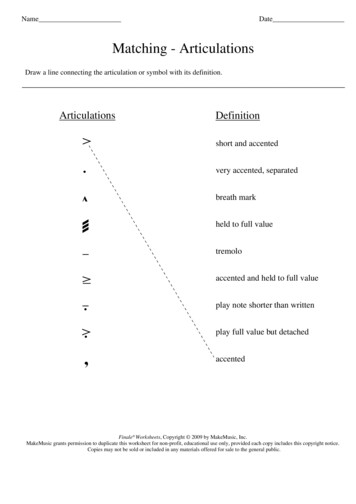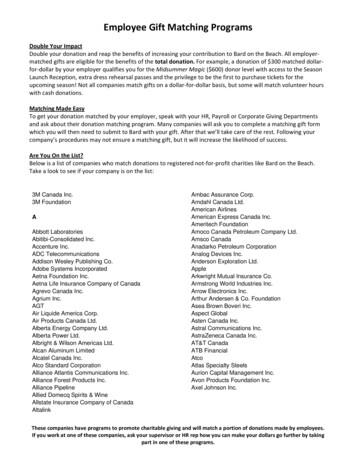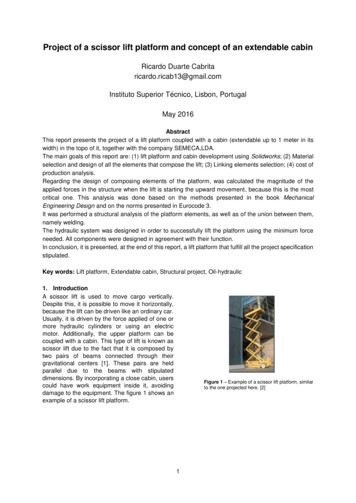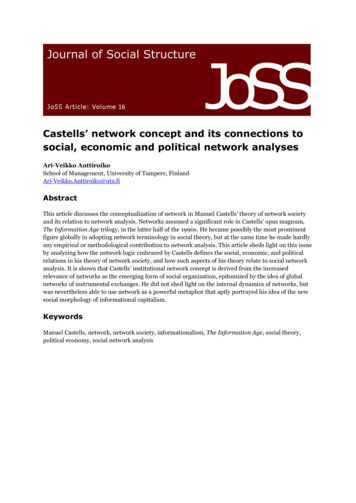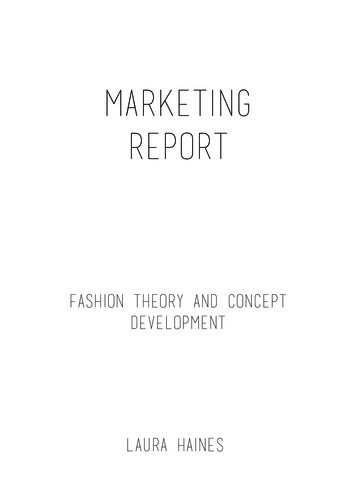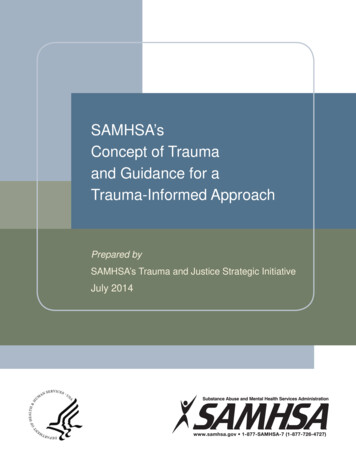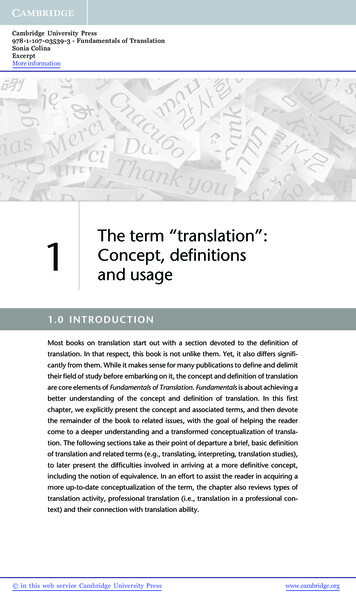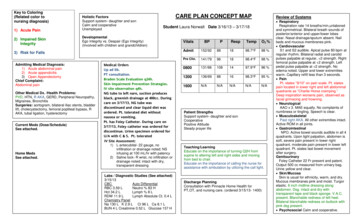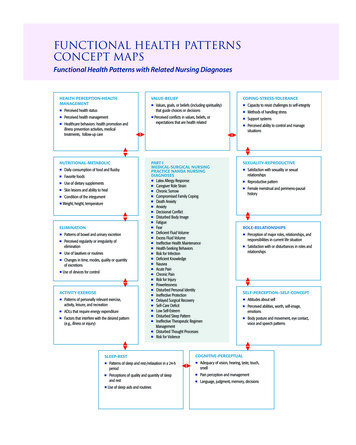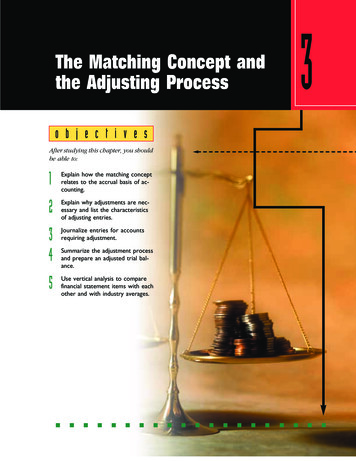
Transcription
The Matching Concept andthe Adjusting Processo b j e c t i v e sAfter studying this chapter, you shouldbe able to:1Explain how the matching conceptrelates to the accrual basis of accounting.2Explain why adjustments are necessary and list the characteristicsof adjusting entries.34Journalize entries for accountsrequiring adjustment.5Use vertical analysis to comparefinancial statement items with eachother and with industry averages.Summarize the adjustment processand prepare an adjusted trial balance.3
Setting the StageAssume that you rented an apartment last month and signed a nine-monthlease. When you signed the lease agreement, you were required to paythe final month’s rent of 500. This amount is not returnable to you.You are now applying for a student loan at a local bank. The loan application requires a listing of all your assets. Should you list the 500 deposit as an asset?The answer to this question is “yes.” The deposit is an asset to you until youreceive the use of the apartment in the ninth month.A business faces similar accounting problems at the end of a period. A businessmust determine what assets, liabilities, and owner’s equity should be reported onits balance sheet. It must also determine what revenues and expenses should be reported on its income statement.As we illustrated in previous chapters, transactions are normally recorded as theytake place. Periodically, financial statements are prepared, summarizing the effectsof the transactions on the financial position and operations of the business.At any one point in time, however, the accounting records may not reflect alltransactions. For example, most businesses do not record the daily use of supplies.Likewise, revenue may have been earned from providing services to customers, yetthe customers have not been billed by the time the accounting period ends. Thus,at the end of the period, the revenue and receivable accounts must be updated.In this chapter, we describe and illustrate this updating process. We will focuson accounts that normally require updating and the journal entries that update them.The Matching Conceptobjective 1Explain how the matchingconcept relates to the accrual basis of accounting.AmericanAirlines usesthe accrual basis of accounting.Revenues are recognizedwhen passengers take flights,not when the passengermakes the reservation orpays for the ticket.When accountants prepare financial statements, theyA bank loanassume that the economic life of the business canofficer requiresbe divided into time periods. Using this accountingan individual,period concept, accountants must determine inwho normallywhich period the revenues and expenses of thekeeps records on a cashbusiness should be reported. To determine thebasis, to list assets (automoappropriate period, accountants will use either (1)biles, homes, investments,the cash basis of accounting or (2) the accrualetc.) on an application for abasis of accounting.loan or a line of credit. Inaddition, the application oftenUnder the cash basis, revenues and expensesasks for an estimate of theare reported in the income statement in the periodindividual’s liabilities, such asin which cash is received or paid. For example, feesoutstanding credit cardare recorded when cash is received from clients,amounts and automobileand wages are recorded when cash is paid to emloan balances. In a sense,ployees. The net income (or net loss) is the differthe loan application convertsence between the cash receipts (revenues) and thethe individual’s cash-basiscash payments (expenses).accounting system to an esUnder the accrual basis, revenues are reportedtimated accrual basis. Thein the income statement in the period in which theyloan officer uses this informaare earned. For example, revenue is reported whention to assess the individual’sability to repay the loan.the services are provided to customers. Cash mayor may not be received from customers during thisperiod. The concept that supports this reporting of revenues is called the revenuerecognition concept.Under the accrual basis, expenses are reported in the same period as the revenuesto which they relate. For example, employee wages are reported as an expense in the
Chapter 3 The Matching Concept and the Adjusting Process101period in which the employees provided services to customers, and notnecessarily when the wages are paid.The matching concept supThe accounting concept that supports reporting revenues and relatedexpenses in the same period is called the matching concept, or matchports reporting revenuesing principle. Under this concept, an income statement will report theand related expenses inresulting income or loss for the period.Generally accepted accounting principles require the use of the accrualthe same period.basis. However, small service businesses may use the cash basis becausethey have few receivables and payables. For example, attorneys, physicians,and real estate agents often use the cash basis. For them, the cash basiswill yield financial statements similar to those prepared under the accrual basis.For most large businesses, the cash basis will not provide accurate financial statements for user needs. For this reason, we will emphasize the accrual basis in theremainder of this text. The accrual basis and its related matching concept requirean analysis and updating of some accounts when financial statements are prepared.In the following paragraphs, we will describe and illustrate this process, called theadjusting process.Nature of the Adjusting Processobjective 2At the end of an accounting period, many of the balances of accounts in the ledgercan be reported, without change, in the financial statements. For example, the balanceof the cash account is normally the amount reported on the balance sheet.Explain why adjustmentsSome accounts in the ledger, however, require updating. For example, the balare necessary and list theances listed for prepaid expenses are normally overstated because the use of thesecharacteristics of adjustingassets is not recorded on a day-to-day basis. The balance of the supplies accountusually represents the cost of supplies at the beginning of the period plus the costentries.of supplies acquired during the period. To record the daily use of supplies wouldrequire many entries with small amounts. In addition, the total amount of suppliesis small relative to other assets, and managers usually do not requireday-to-day information about supplies.The journal entries that bring the accounts up to date at the end of theaccountingperiod are called adjusting entries. All adjusting entries affectAll adjusting entries affectat least one income statement account and one balance sheet account.at least one income stateThus, an adjusting entry will always involve a revenue or an expenseaccountand an asset or a liability account.ment account and one balIs there an easy way to know when an adjusting entry is needed? Yes,ance sheet account.four basic items require adjusting entries. The first two items are deferrals. Deferrals are created by recording a transaction in a way that delaysor defers the recognition of an expense or a revenue, as described below. Deferred expenses, or prepaid expenses, are items that have been initiallyrecorded as assets but are expected to become expenses over time or through thenormal operations of the business. Supplies and prepaid insurance are two examples of prepaid expenses that may require adjustment at the end of an accountingperiod. Other examples include prepaid advertising and prepaid interest.Deferred revenues, or unearned revenues, are items that have been initiallyrecorded as liabilities but are expected to become revenues over time or throughthe normal operations of the business. An example of deferred revenue is unearned rent. Other examples include tuition received in advance by a school,an annual retainer fee received by an attorney, premiums received in advanceby an insurance company, and magazine subscriptions received in advance bya publisher.
102Chapter 3 The Matching Concept and the Adjusting ProcessThe second two items that require adjusting entries are accruals. Accruals arecreated by an unrecorded expense that has been incurred or an unrecorded revenue that has been earned, as described below. Accrued expenses, or accrued liabilities, are expenses that have been incurred but have not been recorded in the accounts. An example of an accruedexpense is accrued wages owed to employees at the end of a period. Other examples include accrued interest on notes payable and accrued taxes.Accrued revenues, or accrued assets, are revenues that have been earned buthave not been recorded in the accounts. An example of an accrued revenue is feesfor services that an attorney has provided but hasn’t billed to the client at the endof the period. Other examples include unbilled commissions by a travel agent, accrued interest on notes receivable, and accrued rent on property rented to others.How do you tell the difference between deferrals and accruals? Determine whencash is received or paid, as shown in Exhibit 1. If cash is received (for revenue)or paid (for expense) in the current period, but the revenue or expense relates toa future period, the revenue or expense is a deferred item. If cash will not bereceived or paid until a future period, but the revenue or expense relates to thecurrent period, the revenue or expense is an accrued item.Exhibit 1 Deferrals andAccrualsCURRENT ACCOUNTING PERIODFUTURE ACCOUNTING PERIODRecording Adjusting Entriesobjective 3Journalize entries for accounts requiring adjustment.The examples of adjusting entries in the following paragraphs are based on theledger of NetSolutions as reported in the December 31, 2002 trial balance in Exhibit 2.To simplify the examples, T accounts are used. The adjusting entries are shown incolor in the accounts to separate them from other transactions.
103Chapter 3 The Matching Concept and the Adjusting ProcessExhibit 2 Unadjusted TrialBalance for NetSolutionsNetSolutionsTrial BalanceDecember 31, 2002CashAccounts ReceivableSuppliesPrepaid InsuranceLandOffice EquipmentAccounts PayableUnearned RentChris Clark, CapitalChris Clark, DrawingFees EarnedWages ExpenseRent ExpenseUtilities ExpenseSupplies ExpenseMiscellaneous Expense22222010204086200005000000000000000009 0 0 003 6 0 0025 0 0 0 004 0 0 0 0016 3 4 0 004 2 71 6 09 88 04 542 6 050505000000000000042 6 0 0 00An expanded chart of accounts for NetSolutions is shown in Exhibit 3. The additional accounts that will be used in this chapter are shown in color.Exhibit 3 Expanded Chartof Accounts for NetSolutionsBalance Sheet Accounts1. AssetsCashAccounts ReceivableSuppliesPrepaid InsuranceLandOffice EquipmentAccumulated Depreciation2. Liabilities21 Accounts Payable22 Wages Payable23 Unearned Rent3. Owner’s Equity31 Chris Clark, Capital32 Chris Clark, Drawing11121415171819Income Statement Accounts4142515253545556594. RevenueFees EarnedRent Revenue5. ExpensesWages ExpenseRent ExpenseDepreciation ExpenseUtilities ExpenseSupplies ExpenseInsurance ExpenseMiscellaneous ExpenseDeferred Expenses (Prepaid Expenses)The concept of adjusting the accounting records was introduced in Chapters 1 and2 in the illustration for NetSolutions. In that illustration, supplies were purchased onNovember 10 (transaction c). The supplies used during November were recordedon November 30 (transaction g).
104Chapter 3 The Matching Concept and the Adjusting ProcessThe balance in NetSolutions’ supplies account on December 31 is 2,000. Someof these supplies (computer diskettes, paper, envelopes, etc.) were used during December, and some are still on hand (not used). If either amount is known, the othercan be determined. It is normally easier to determine the cost of the supplies onhand at the end of the month than it is to keep a daily record of those used. Assuming that on December 31 the amount of supplies on hand is 760, the amountto be transferred from the asset account to the expense account is 1,240, computedas follows:Supplies available during December (balance of account)Supplies on hand, December 31 2,000760Supplies used (amount of adjustment) 1,240As we discussed in Chapter 2, increases in expense accounts are recorded asdebits and decreases in asset accounts are recorded as credits. Hence, at the end ofDecember, the supplies expense account should be debited for 1,240, and thesupplies account should be credited for 1,240 to record the supplies used duringDecember. The adjusting journal entry and T accounts for Supplies and SuppliesExpense are as follows:200223Dec. 31 Supplies ExpenseSupplies5514SuppliesBal.2,000Dec. 311 2 4 0 0021 2 4 0 003Supplies Expense1,240760Bal.Dec. 318001,2402,040After the adjustment has been recorded and posted, the supplies account has a debit balance of 760. This balance represents an asset thatwill become an expense in a future period.The debit balance of 2,400 in NetSolutions’ prepaid insuranceaccount represents a December 1 prepayment of insurance for 24 months.At the end of December, the insurance expense account should be increased (debited), and the prepaid insurance account should be decreased(credited) by 100, the insurance for one month. The adjusting journalentry and T accounts for Prepaid Insurance and Insurance Expense are asfollows:The balance of a prepaid(deferred) expense is anasset that will become anexpense in a future period.5631 Insurance ExpensePrepaid Insurance5615Prepaid InsuranceBal.2,3002,400Dec. 311 0 0 00Insurance Expense100Dec. 3151 0 0 001006
105Chapter 3 The Matching Concept and the Adjusting ProcessThe tuition youpay at the beginning of eachterm is an exampleof a deferred expense toyou, as a student.After the adjustment has been recorded and posted, the prepaid insurance account has a debit balance of 2,300. This balance represents an asset that will become an expense in future periods. The insurance expense account has a debit balance of 100, which is an expense of the current period.What is the effect of omitting adjusting entries? If the preceding adjustments forsupplies ( 1,240) and insurance ( 100) are not recorded, the financial statementsprepared as of December 31 will be misstated. On the income statement, SuppliesExpense and Insurance Expense will be understated by a total of 1,340, and netincome will be overstated by 1,340. On the balance sheet, Supplies and PrepaidInsurance will be overstated by a total of 1,340. Since net income increases owner’sequity, Chris Clark, Capital will also be overstated by 1,340 on the balance sheet.The effects of omitting these adjusting entries on the income statement and balancesheet are shown below.Amount ofMisstatementIncome StatementRevenues correctly statedExpenses understated byNet income overstated bySupplies of 1,250 were onhand at the beginning of the period, supplies of 3,800 were purchased duringthe period, and supplies of 1,000 were on hand at theend of the period. What is thesupplies expense for the period? 4,050 ( 1,250 3,800 1,000)Balance SheetAssets overstated by XXX(1,340)(1) 1,340 1,340Liabilities correctly statedOwner’s equity overstated by XXX1,340Total liabilities andowner’s equity overstated by 1,340(2)Arrow (1) indicates the effect of the understated expenses on assets. Arrow (2)indicates the effect of the overstated net income on owner’s equity.Prepayments of expenses are sometimes made at the beginning of the period inwhich they will be entirely consumed. On December 1, for example, NetSolutions paidrent of 800 for the month. On December 1, the rent payment represents the asset prepaid rent. The prepaid rent expires daily, and at the end of December, the entireamount has become an expense (rent expense). In cases such as this, the initial payment is recorded as an expense rather than as an asset. Thus, if the payment is recordedas a debit to Rent Expense, no adjusting entry is needed at the end of the period.1Deferred Revenue (Unearned Revenue)According to NetSolutions’ trial balance on December 31, the balance in the unearned rent account is 360. This balance represents the receipt of three months’rent on December 1 for December, January, and February. At the end of December, the unearned rent account should be decreased (debited) by 120, and the rentrevenue account should be increased (credited) by 120. The 120 represents therental revenue for one month ( 360/3). The adjusting journal entry and T accountsare shown below.89131 Unearned RentRent Revenue23421 2 0 0081 2 0 009This alternative treatment of recording the cost of supplies, rent, and other prepayments of expenses is discussed in Appendix C.
106Chapter 3 The Matching Concept and the Adjusting ProcessUnearned RentSears,Roebuck andCo. sells extended warrantycontracts with terms between12 and 36 months. The receipts from sales of thesecontracts are reported asunearned revenue (deferredrevenue) on Sears’ balancesheet. Revenue is recordedas the contracts expire.If NetSolutions’adjustment forunearned rent hadincorrectly been made for 180instead of 120, what wouldhave been the effect on thefinancial statements?Revenues would have beenoverstated by 60; net income would have beenoverstated by 60; liabilitieswould have been understatedby 60; and owner’s equitywould have been overstatedby 60.Dec. 31120Bal.Rent Revenue360Dec. 31120240After the adjustment has been recorded and posted, the unearned rent account,which is a liability, has a credit balance of 240. This amount represents a deferralthat will become revenue in a future period. The rent revenue account has a balance of 120, which is revenue of the current period.2If the preceding adjustment of unearned rent and rent revenue is not recorded,the financial statements prepared on December 31 will be misstated. On the incomestatement, Rent Revenue and the net income will be understated by 120. On thebalance sheet, Unearned Rent will be overstated by 120, and Chris Clark, Capitalwill be understated by 120. The effects of omitting this adjusting entry are shownbelow.Amount ofMisstatementIncome StatementRevenues understated byExpenses correctly statedNet income understated byBalance SheetAssets correctly stated2 (120)XXX (120) XXXLiabilities overstated byOwner’s equity understated by 120(120)Total liabilities andowner’s equity correctly stated XXXAn alternative treatment of recording revenues received in advance of their being earned is discussed inAppendix C.BUSINESS ON STAGETechnology and BusinessThe business environment is adynamic one in which there is constant change, with challenges andopportunities. The current technologyrevolution affects all businesses.Computer and telecommunicationtechnologies affect the production,storage, and use of information bybusinesses. Many businesses havedeveloped web sites for use in marketing products and services, and forcommunicating with stakeholders.New software applications range fromaccounting software that providesupdated accounting information tobusiness simulation software capableof gauging the impact of alternativebusiness decisions on operations.The technological revolutionchallenges businesses to adapt quicklyto software and hardware improvements. Such improvements offer opportunities for businesses to developnew products, reach more customers,develop new channels of product distribution, lower operating costs, im-prove product quality, obtain immediate customer feedback, and reactquickly to market changes. Businessesunable to adapt quickly to the technological revolution may find themselvesat a competitive disadvantage.Technology also provides youwith new and exciting opportunities.To the extent that you develop yourcomputer and technological skills andtalents, you will improve your chancesof finding a job and advancing rapidlyin your career.
107Chapter 3 The Matching Concept and the Adjusting ProcessAccrued Expenses (Accrued Liabilities)CallawayGolf Comp
In the following paragraphs, we will describe and illustrate this process, called the adjusting process. The matching concept sup-ports reporting revenues and related expenses in the same period. At the end of an accounting period, many of the balances of accounts in the ledger can
